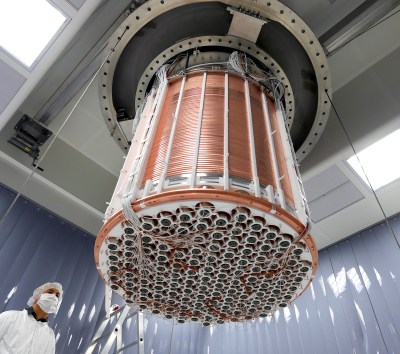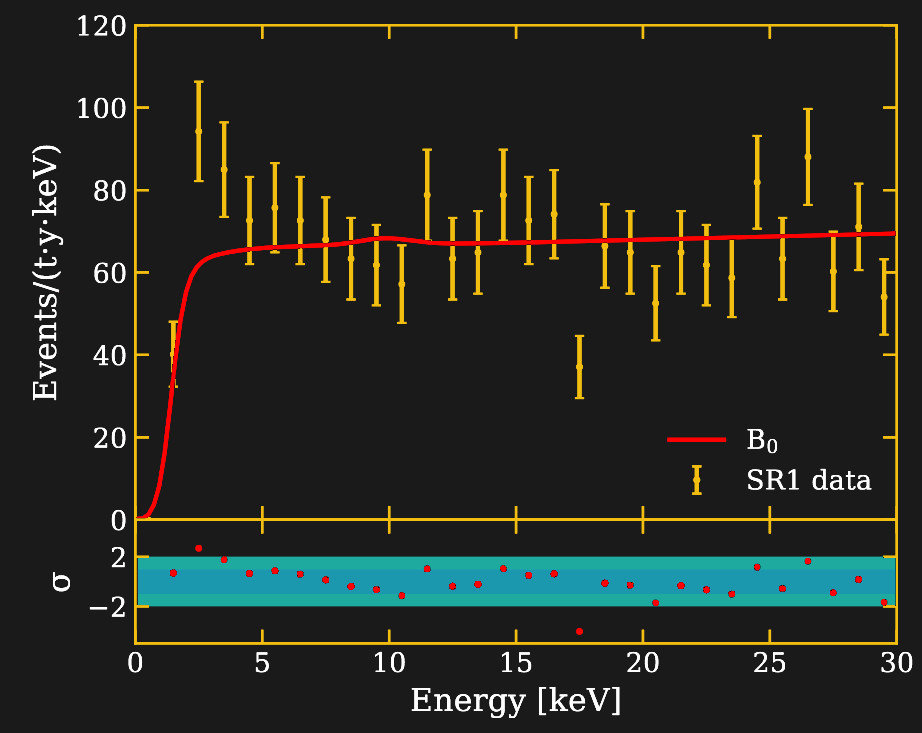For decades scientists have been building detectors deep underground to search for dark matter. Now one of these experiments, the XENON1T detector, has found an unexpected signal in their data. Although the signal does not stem from dark matter it may still revolutionize physics.
Since the 1980s the majority of scientists believe that the most likely explanation for the missing mass problem is some yet undiscovered Weakly Interacting Massive Particle (WIMP). They also figured that if you build a large and sensitive enough detector we should be able to catch these particles which are constantly streaming through Earth. So since the early 1990s, we have been putting detectors made from ultrapure materials in tunnels and mines where they are shielded from cosmic radiation and natural radioactivity.
Over the decades these detectors have increased their sensitivity by a factor of about 10 million due to ever more sophisticated techniques of shielding and discriminating against before mentioned backgrounds. So far they haven’t found dark matter, but that doesn’t mean the high-end sensing installations will go unused.
No Dark Matter So Far
Unfortunately, apart from a long-standing unconvincing claim, WIMP searches have yet found nada. Still, the search continues and everybody hopes that WIMPs are just around the corner as experiments will soon hit the sensitivity limit due to the background from neutrinos. Lately, people have developed ambiguous opinions of whether the field is already dead and some argue that we should diversify the search for dark matter instead of focussing on WIMPs.
The dwindling hopes of detecting WIMPs also inspired the collaborations running these experiments to think of other interesting physics searches. After all, having a super-sensitive detector not only lets you search for WIMPs but also for other exotic particles and rare nuclear decays plus one can do some interesting neutrino physics. Having a broad physics program helps to secure funding and keeps your Ph.D. students busy. Earlier this year the world’s most sensitive dark matter experiment, XENON1T, was able to measure the double electron capture decay in Xe-124. With a half-life of ~1022 years this is the rarest decay ever measured, 12 orders of magnitude longer than the age of the universe.
Detecting Particles in Liquid Xenon

Credit: E. Shockley

Credit: XENON1T collaboration
The XENON1T detector is a so-called dual-phase time projection chamber (TPC). It consists of a cylindrical tank filled with the noble gas xenon cooled down to its liquid state. Above the liquid, there is also a gaseous phase, and an electric field is applied between the two. Whenever a particle interacts in the liquid it produces a flash of light (S1) which is detected by an array of light sensors located at the top and bottom of the tank. In addition, the charges produced in the particle interaction are swept to the top by the electric field and produce another flash of light (S2) when they enter the gas layer. From the time difference between both signals S1 and S2, it is possible to reconstruct the z-position (height) of the particle interaction while the distribution of light seen by the top and bottom arrays allows the array to determine the xy-position. In addition, the energy deposited by the particle can be deduced from the combined intensity of both light flashes while their ratio S2/S1 provides some information about the type of interacting particle. The latter makes it possible to distinguish if a particle interacted with the electrons of a xenon atom, as is the case for radioactivity from beta decays and gamma-rays, or if the particle bounced off a xenon nucleus, as WIMPs or neutrons do.
An Unexpected Signal
While an earlier published WIMP search did unfortunately not reveal any signal, in their latest analysis, the XENON1T collaboration looked more closely at the electron recoil data which is normally disregarded as background. As mentioned, most of these types of events come from radioactive contamination of the xenon and the surrounding materials. This background was modeled by Monte-Carlo simulations and constraint by separate measurements, e.g. by the previous screening of materials for their radioactivity. When the collaboration looked at the data and compared it to the background model this is what they saw.

The data shows an excess of events between energies of 1 to 7 keV which peaks around 2 keV. By counting the events in this energy region and comparing it to the number of expected events from the background model, one gets a 3.5-sigma fluctuation. This means the probability to observe that many events for the given background model is merely 0.02%. While this sounds like it is safe to exclude a statistical fluctuation there have actually been a number of excesses in particle physics with a similar significance which later vanished. The most prominent example is the 750 GeV diphoton excess at the LHC, which had a significance of up to 3.9 sigma and led to the authorship of over 500 articles but turned out to be just a statistical fluke. Still, the XENON1T result calls for some interpretation of the data, and the collaboration studied three possibilities.
Did Someone Drop Their Watch?
According to Occam’s razor the most likely but also most boring explanation would be some kind of yet unaccounted background. It turns out that the beta decay of tritium, the unstable form of hydrogen with two additional neutrons, has a shape that resembles the observed excess. Tritium is also the stuff that excites the phosphor in self-glowing watches. A tiny fraction of hydrogen atoms, about 10-18, are tritium which is naturally produced by cosmic rays in the atmosphere. Therefore, a concentration of about 60 ppb of hydrogen or water inside the XENON1T detector could explain the observed excess, although the collaboration thinks the actual concentration should be ~100x lower.
Axions from the Sun
The more exciting interpretations of the signal are those that involve new physics and one of them would be the detection of solar axions. Axions are hypothetical particles, named after a brand of laundry detergent, and were postulated to solve a “fine-tuning” problem in particle physics. Axions are probably also the second most favorable dark matter candidate after WIMPs. However, dark matter axions have very small masses and need a totally different kind of detector technology to be searched for that involves microwave cavities. But axions with higher masses detectable by XENON1T can be produced in the sun through different processes such as the Primakoff effect. A statistical analysis shows that the data favors an axion signal with a significance of 3.2 sigma over the background model. If tritium is added to the background the axion signal is still favored but with a reduced significance of 2.1 sigma.
Neutrinos are not so Standard
The second interesting explanation of the signal comes from particles that we already know exist, namely neutrinos. Much like WIMPs, neutrinos are only weakly interacting and therefore show up very rarely in the detector. In fact, they were already considered in the background model but their contribution is minor. However, there are theories beyond the current Standard Model of particle physics that propose a higher interaction probability for neutrinos at low energies caused by a higher than usual magnetic moment of these particles. Fitting the data with this non-standard neutrino model gives a similar statistical significance as the axion model. But in this case, adding the tritium component reduces the significance to only 0.9 sigma.
Problems from Cooling Stars
One problem that should make us skeptical about the new physics interpretations of the signal is the fact that they are in tension with astrophysical observations. The properties of solar axions and the neutrino magnetic moment are constrained by studies about the cooling rate of stars which would lose additional energy through the emission of these particles. These constraints are in tension with the properties derived from the XENON1T data. On the other hand, particle physicists tend to not take astrophysical constraints too seriously because of the uncertainties involved in their models. Also, some astrophysical observations point towards an additional source of stellar cooling compatible with axions even if the parameters are different.
If the signal would be confirmed to originate from new physics the impact would be huge. It would be the first confirmation of physics beyond the Standard Model since the discovery of neutrino oscillations and therefore even outshine the discovery of the Higgs boson and the detection of gravitational waves. The good thing is that we should not have to wait too long until the situation is cleared up as the XENONnT, LZ, and PandaX-4T experiments are currently racing to build the next most sensitive WIMP detector. It looks like XENONnT will make the game as their detector is already being commissioned. With about three times as much xenon and a factor of ~6 lower background, the signal could be confirmed after only a few months of data collection. In the meantime, theorists have already started the publishing frenzy to come with new physics models that explain the excess, all hoping that this time the result will stick.
No comments:
Post a Comment